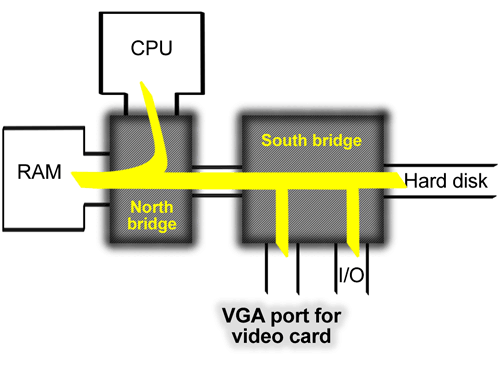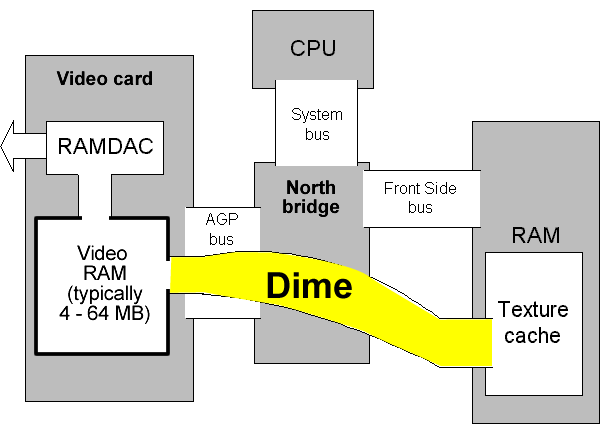Copyright Michael Karbo and ELI Aps., Denmark, Europe.
Chapter 23. Data for the monitor
I have several times mentioned the AGP port, which is directly connected to the CPU and RAM. It is a high-speed port used for the video card, which has itís own RAM access.
|
|
Fig. † Figur 151. AGP is a high-speed bus for the video card, developed by Intel. |
About screens and video cards
As users, we communicate with PC programs via the screen. The screen shows us a graphical representation of the software which is loaded and active in the PC. But the screen has to be fed data in order to show a picture. This data comes from the video card, which is a controller.
Screens can be analogue (the traditional, big and heavy CRT monitors) or digital devices, like the modern, flat TFT screens. Whatever the case, the screen has to be controlled by the PC (and ultimately by the CPU). This screen control takes place using a video card.
A video card can be built in two ways:
Finally, the video card can be connected either to the PCI bus, the AGP bus or the PCI Express x16 bus.
Big bandwidth
Traditionally, the video card (also called the graphics card) was connected as an I/O device. This meant that data for the video card was transferred using the same I/O bus which looks after data transfer to and from the hard disks, network card, etc.
In the late 1990ís, the demands placed on the graphics system increased dramatically. This was especially due to the spread of the many 3D games (like Quake, etc.). These games require enormous amounts of data, and that places demands on the bus connection. At that time, the video card was connected to the PCI bus, which has a limited bandwidth of 133 MB/sec. The same bus, as just mentioned, also looks after the hard disk and other I/O devices, which all need bandwidth. The PCI bus therefore became a bottleneck, and the solution to the problem was to release the video card from the I/O bus.
 Fig. 152. The data path to the video card
before the AGP standard.
Fig. 152. The data path to the video card
before the AGP standard.
AGP
AGP (Accelerated Graphics Port) is a special I/O port which is designed exclusively for video cards. AGP was developed by Intel. The AGP port is located close to the chipsetís north bridge.
 Fig. 153. The AGP slot can be seen on this motherboard, left of the three PCI
slots.
Fig. 153. The AGP slot can be seen on this motherboard, left of the three PCI
slots.
The video card port was moved from the south to the north bridge. The new architecture gives optimal access to RAM and hence to the bandwidth which the 3D games require.
At the same time, the PCI system is spared from the large amount of graphic data traffic to and from the video card. It can now focus on the other intensive transfer tasks, such as transfer to and from the network adapter and disk drive.
 Fig. 154. AGP Video card from ATI.
Fig. 154. AGP Video card from ATI.
Technical details
AGP consists of a number of different technical elements, of which I will highlight two:
The texture cache is used by games, and by giving access to the motherboard RAM, less RAM is needed on the cards.
The AGP bus is actually a 64-bit variant of the PCI bus. You can also see that on the surface, the motherboard AGP slot looks a fair bit like a PCI slot. But it is placed in a different position on the motherboard, to avoid confusion (see Fig. 156). The slot also has a different colour.
The first version of AGP was 1X, with a bandwidth of 254 MB/sec. But AGP was quickly released in a new mode, called 2X, with 508 MB/sec.
Later came 4X and 8X, which are the standards today. This involves a clock doubling, just as we have seen, for example, with DDR RAM. Two or four data packets are sent for each clock pulse. In this way, a bandwidth of 2,032 MB/sec has been reached.
Texture cache and RAMDAC
Textures are things like backgrounds in games. They can be uploaded directly from RAM to the video card. The system is called DIME (Direct Memory Execute). This allows the video card memory to be extended using standard RAM on the motherboard. In Fig. 155 you can see the system shown graphically.
In this figure you can also see the RAMDAC device. This is a chip on the video card which looks after the ďtranslationĒ of digital data into analogue signals, when the card is connected to an analogue screen. The RAMDAC is a complete little processor in itself; the higher itís clock frequency, the higher the refresh rate with which the card can supply the screen image.
 Fig. † Figur 155. The AGP bus provides direct access to RAM.
Fig. † Figur 155. The AGP bus provides direct access to RAM.
Video card on PCI Express
With the new PCI Express bus, we get a new system for the video card. Replacing the AGP, the PCI Express X16-bus offers a transfer of 8 GB/sec, which leaves plenty of room for even the most graphical-intensive pc games.

There are a lot of I/O ports in the PCís architecture, with their associated I/O devices and standards. I/O stands for Input/Output, and these ports can both send and receive data from the processor and RAM.
The I/O system provides flexibility
The use of I/O devices has contributed to making the PC an incredibly flexible machine. Computers can be used for anything from normal office tasks, processing text and numbers, to image processing using scanners and cameras, to producing video, light and music.
The PC can also be used industrially. In 1987-88 I worked in a company that produced special PCís which could control the production of concrete. This was achieved using special I/O cards which could monitor the weighing of sand, gravel, cement and water. The core of the system was a standard office PC from Olivetti.
This particularly flexible architecture is based on an I/O system which can be extended almost without limit. This is one place we really see the PCís open architecture: any engineer or technician can, in principle, develop their own plug-in cards and other special devices, if they just meet one of the I/O standards. The opportunities for extension really are unlimited!
In the following chapters we will look at the various I/O buses which link the PCís other devices with the CPU and RAM.
